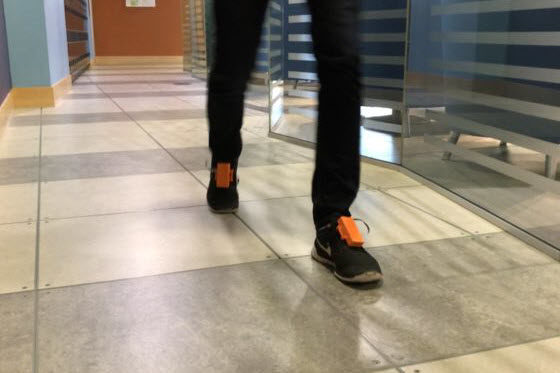A new research study looks at the connection between being on your feet for long periods and painful foot conditions — something I know all too well.

The orange devices on these shoes are connected to
high-tech insoles that measure weight-bearing activity.
Photo credit: Evan Macdonald, Mechatronic Systems
Engineering, Simon Fraser University
Plantar fasciitis (PF) is an inflammation of the “plantar fascia,” a thick band of tissue that connects the heel to the toes — and I have first-hand knowledge of this painful foot condition.
It happened many years ago when I worked in a mailroom. I stood in one spot for most of my eight-hour shift, only occasionally walking a few steps. After a few weeks, I noticed a sharp, burning pain that ran along the bottoms of my feet. It kept getting worse, so I went to my doctor and was diagnosed with PF. She suggested I spend less time standing at work and told me to put supportive heel cups in my shoes.
I got the heel cups, which helped a bit, but I felt too embarrassed to tell my coworkers I needed to stand less. After all, didn’t everyone get sore feet from standing?
“Foot pain is one of those things that isn’t severe enough to pay attention to — until you have it, and then it’s really debilitating,” says Dr. Carolyn Sparrey, a professor at Simon Fraser University and lead researcher on Feet first: Instrumental insoles to examine workplace injury risk, a study funded by a WorkSafeBC research grant.
Research aims to inform decisions to prevent foot pain
The goal of Carolyn’s research is to determine the connection between PF and being on one’s feet for an extended period of time. To help gather data, the study team, which includes Dr. Michael Ryan, head of research and development for Kintec Footlabs Inc., developed and tested a high-tech insole that measures how much pressure people apply to the bottoms of their feet. The pressure data is then used to classify participants’ activities throughout the day.
In the first phase of the study, the team used the insoles to monitor 35 people at work for one week. Some of these workers spent 80 percent of their work shift on their feet, while others spent 98 percent of their time sitting. In addition to the data collected from the insole sensors, researchers also videotaped people doing specific activities.
The study is still ongoing, but once they’ve finished their research, the team hopes it will help employers determine what changes should be made in their workplaces to address foot pain.
“The data from the study will allow people to make more research-informed decisions,” says Carolyn. “Can they modify the workplace? Would it make a difference to have somebody sit more or walk more instead of just standing still? Should they change out the flooring or footwear?”
Thanks to Carolyn for telling me about their research. After having personally experienced foot pain (which is long gone now, thankfully), I’m glad to hear there are potential solutions afoot!
Read more about the study in the January/February 2019 issue of WorkSafe Magazine.


